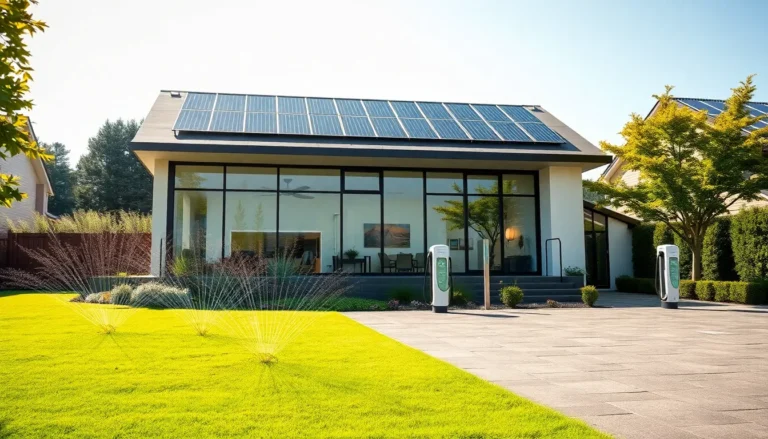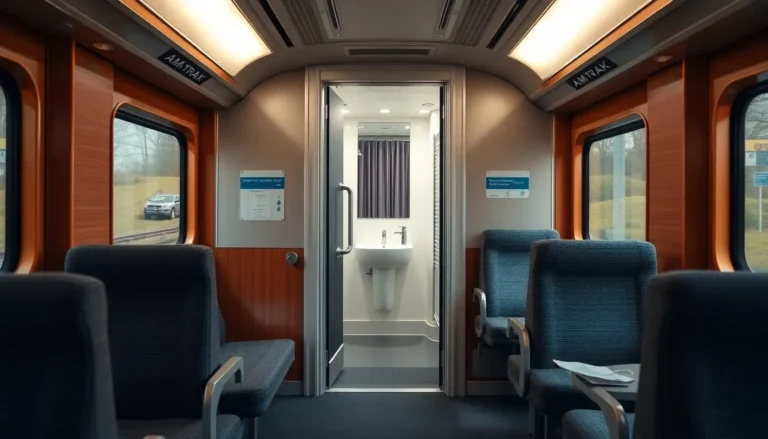Imagine walking into your home and having it greet you like an old friend. Smart home remodeling isn’t just a trend; it’s the future knocking at your door—probably with a robotic vacuum in tow. As technology evolves, so does the way people think about their living spaces. Gone are the days of simply slapping on a fresh coat of paint; now, homes can be as intelligent as they are stylish.
Table of Contents
ToggleOverview of Smart Home Remodeling
Smart home remodeling combines technology with design to enhance living spaces. This approach integrates various smart devices, including lighting, heating, and security systems, to create a connected environment. Homeowners increasingly prioritize convenience and efficiency in their living situations, prompting a shift from basic updates to sophisticated remodeling solutions.
Energy efficiency serves as a core principle of smart home remodeling. Smart thermostats, for instance, adjust temperatures based on occupancy, resulting in energy savings. Automated lighting systems enable users to control ambiance with ease, further enhancing comfort and utility.
Security remains a top concern for many homeowners. Smart security devices include cameras, motion sensors, and smart locks that can be monitored remotely. They provide homeowners with peace of mind through real-time alerts and accessible footage.
Home automation platforms unify various devices, allowing for seamless integration and control. Homeowners can set schedules or use voice commands to interact with their systems. This level of control creates a customized living experience tailored to individual preferences.
Aesthetic considerations play a significant role in smart home remodeling. Designers often opt for sleek, modern devices that blend with existing decor. This ensures that technology enhances rather than detracts from the home’s visual appeal.
Investment in smart home features typically yields a higher return on investment. According to recent studies, smart homes can command higher property values and attract tech-savvy buyers. Homeowners gain not only immediate benefits but also long-term financial security.
Smart home remodeling reflects a significant shift in modern living. It merges technology with thoughtful design to create homes that are functional, secure, and visually appealing.
Benefits of Smart Home Remodeling

Smart home remodeling offers numerous advantages, enhancing both functionality and style. This trend significantly impacts homeowners by improving comfort and convenience.
Increased Energy Efficiency
Energy efficiency ranks high among the benefits of smart home remodeling. Smart thermostats adjust heating and cooling based on occupancy, resulting in energy savings of up to 30%. Automated lighting systems use sensors to turn off lights in unoccupied rooms, reducing electricity waste. Additionally, smart appliances optimize energy usage during off-peak hours, further lowering utility bills. Homeowners often find that these upgrades contribute to a more sustainable lifestyle, aligning with modern efficiency goals. Integrating solar panels with smart technology can also bolster energy savings by managing power generation and consumption effectively.
Enhanced Security Features
Enhanced security features are another significant benefit of smart home remodeling. Smart locks provide remote access control, allowing users to manage entry points from anywhere. Security cameras with real-time monitoring offer reassurance and can alert homeowners to unusual activities instantly. Motion sensors detect movement and can trigger alerts, ensuring safety when homeowners are away. Integrating these devices into a home automation system allows for seamless monitoring, creating a cohesive security environment. Safety measures like automated lighting can deter intruders, enhancing overall peace of mind. These innovations transform homes into secure havens, prioritizing the protection of loved ones and property.
Popular Smart Home Technologies
Smart home technologies encompass various innovative solutions that enhance functionality and convenience. Many homeowners gravitate toward these advancements for improved living experiences.
Smart Lighting Solutions
Smart lighting solutions allow users to control their home’s ambiance effortlessly. Programmable LED lights offer flexibility in adjusting brightness and color, catering to various moods. Voice-activated systems provide convenience for hands-free control. These technologies can integrate with home automation platforms, creating schedules and scenes. According to studies, smart lighting can reduce energy usage by up to 75% compared to traditional lighting.
Smart Thermostats
Smart thermostats provide precise control over home heating and cooling systems. Users can set schedules based on occupancy patterns, ensuring comfort when at home and saving energy when away. Many smart models learn preferences over time and automatically adjust settings for optimal efficiency. It’s reported that smart thermostats can lead to energy savings of up to 30%, significantly lowering utility bills. Remote access via smartphone apps enhances convenience, allowing adjustments from anywhere.
Home Automation Systems
Home automation systems serve as the central hub for managing smart devices throughout a residence. These platforms enable seamless control of lighting, heating, and security, all from one interface. Users can customize settings according to their lifestyle, triggering actions based on certain conditions or preferences. Integration with voice assistants amplifies accessibility, allowing commands through simple verbal instructions. Research shows that homes equipped with automation systems experience enhanced security and energy efficiency.
Planning Your Smart Home Remodel
Smart home remodeling requires careful planning to ensure optimal integration of technology into living spaces. Prioritizing key areas like budgeting and product selection can simplify the remodeling process.
Budgeting for Technology
Budgeting plays a critical role in any remodel. Establishing a clear financial plan sets expectations and helps identify which technologies are feasible. Smart devices, like thermostats and lighting systems, vary significantly in price, influencing choices. Allocating funds for both primary installations and upgrades ensures homeowners gain the best features. It’s essential to consider costs of installation, which can range from $50 to $200 per device, varying based on complexity. Including a contingency fund for unexpected expenses can lead to a smoother renovation experience.
Choosing the Right Products
Selecting the right products elevates the overall effectiveness of smart home features. Smart lighting, smart thermostats, and home security devices represent essential categories to consider. Analyzing product compatibility with existing systems improves overall functionality. Evaluating energy-saving capabilities is vital; smart thermostats can reduce energy bills by up to 30%. Homeowners should read reviews and consult expert recommendations to make informed choices. Prioritizing devices with seamless integration capabilities simplifies management and enhances user experience. Ultimately, the right product selection contributes significantly to a functional and stylish smart home environment.
Common Challenges in Smart Home Remodeling
Smart home remodeling presents unique challenges. Homeowners often face issues related to integration and technology limitations.
Integration with Existing Systems
Integrating smart home devices with existing systems is frequently complex. Many older homes feature outdated electrical setups, which may not support modern smart technology. Compatibility between devices also poses a challenge, as some brands do not seamlessly communicate with others. Ensuring a cohesive network involves strategic planning. Homeowners often require expert advice to optimize their systems. Skilled professionals can assess current setups and recommend suitable upgrades. Taking these steps minimizes frustration and enhances overall efficiency.
Understanding Technology Limitations
Another challenge lies in understanding technology limitations. Smart devices can enhance daily life but may rely heavily on a stable internet connection. Network issues can disrupt functionality and lead to inconvenience. Additionally, some devices have a steep learning curve, posing difficulties for users unfamiliar with technology. Homeowners must also consider the lifespan of devices, as rapid advancements may render some products obsolete. Budget restrictions may limit choices, requiring careful evaluation of long-term value. Being aware of these limitations helps homeowners make informed decisions about their smart home upgrades.
Smart home remodeling is reshaping the way people experience their living spaces. By merging technology with design homeowners can create environments that are not only functional but also secure and stylish. This transformation prioritizes energy efficiency and convenience while addressing the growing need for enhanced security.
As technology continues to evolve homeowners must approach smart remodeling with careful planning and informed choices. Understanding the challenges associated with device integration and compatibility is essential for a successful upgrade. With the right strategies homeowners can enjoy the benefits of a connected home that meets their unique needs and preferences. Embracing smart home remodeling is a step towards a more efficient and enjoyable lifestyle.


